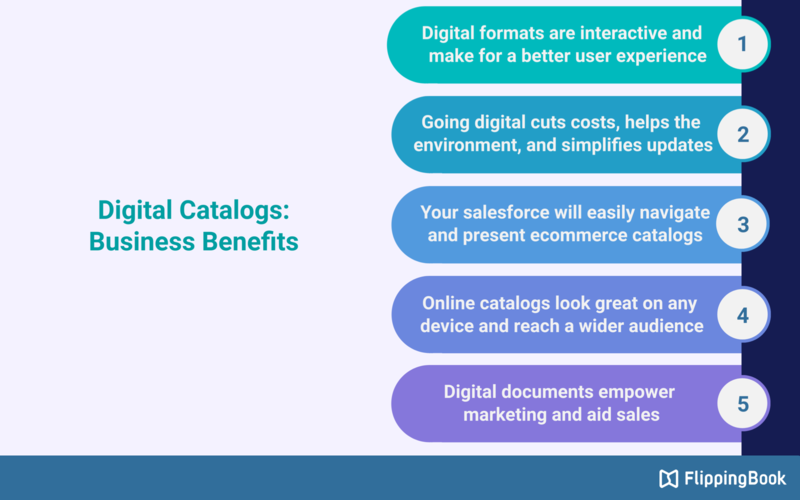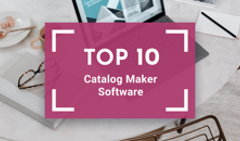Are printed catalogs still a thing? They sure are: some people enjoy browsing for products in an old-fashioned way, others like the tactile experience of flipping through pages, and some just embrace the nostalgia of receiving a catalog in the mail. Yet, digital channels are slowly rising to the top as the preferred way of shopping. It's a tendency you can't overlook, and online catalogs can become a valuable tool to use in your favor and get ahead of the competition. Want to find out how? Then read on.
What Is a Digital Catalog
Digital catalogs, or online product catalogs, are an essential document for every ecommerce specialist. They represent a digital version of the classic paper catalog—its modern alternative, if you will. A digital catalog is a convenient collection of product data, neatly organized and readily available to brand owners, employees, and customers. Compared to print, it alleviates the sustainability concern and offers other significant benefits, which we will explore in this article.
Digital Catalogs 101
🔹 Who uses digital catalogs? Basically, everyone! Retail stores, ecommerce websites, wholesalers, product manufacturers—and the varied target audiences these businesses have. You'll easily find an example in any industry you can think of, B2B or B2C. Regular consumers pick out home decor and custom clothes on a commute or as part of retail therapy. A company owner chooses an office property in a real estate catalog, while a doctor decides which patient care supplies to order through a medical brochure.
🔹 Why make digital catalogs? Digital catalogs effectively showcase products for potential buyers in a visual, well-organized way. By 2040, the ecommerce sector is predicted to account for 95% of all sales. And even today, 79% of shoppers purchase something online at least once a month. Going digital is a necessity for businesses that want to continue growing their sales and stay competitive. And online product catalogs are a stepping stone toward that goal.
🔹 What's inside a digital catalog? The core elements of an ecommerce catalog are product descriptions, images, and pricing. If the document comes in the PDF format, you can also add links and create a table of contents through bookmarks—and that's it. For the catalog to have interactive elements like videos, pop-ups, image galleries, and GIFs, you'll have to consider a different format. Look into flipbooks, for example—interactive digital publications based on PDF files that you can share as direct links or embed to your website.
Have a PDF catalog?
Check out our video on how to create powerful interactive catalogs and wow your readers right away!
Why Digital Catalogs Are Great for Business
No matter what industry you're in, digital catalog formats come with universal perks: they can transform your sales and marketing strategies, lift the weight off your budget, and make for better customer experience and brand image. If you want the gist of all the benefits we'll describe below, take a look at the picture below.

How Ecommerce Benefits From Digital Products Catalogs
A digital catalog is more than just a piece of collateral: it serves as a crucial touchpoint that your customers and employees interact with on a daily basis.
Better search and management of digital catalogs, easy placement of catalogs on the website, simple catalog updates, linking products to the e-shop directly from the catalog—all these features lead to higher purchase conversion rates through the e-shop for our customers.
The format and design of your catalog shapes the reading experience and influences how your products are perceived. For your workforce, easy access and data insights empower sales and marketing strategies. Every detail, from aesthetics to functionality, contributes to the overall impression of your brand. So here's how you can harness the power of digital catalogs to enhance your ecommerce strategy:
#1 Promote Sustainability
Needless to say, printing hundreds of catalogs does not make a good impact on the environment. Reducing paper waste is not only one of the latest digital marketing trends, but also a continuous courtesy to our planet. Even IKEA canceled their legendary wholesale catalog several years ago and switched to a digital version. Online catalogs can help companies be more sustainable in today's eco-conscious world.
➡️ Read a success story on how online shopping catalogs catalogs helped Food Huggers, a food-saving product retailer, meet their sustainability goals. Or watch a video where Schréder, a leading outdoor lighting solution provider, revolutionizes the way the company distributes its catalogs by turning them into interactive digital flipbooks with the help of FlippingBook, a digital catalog maker.
#2 Cut Costs
The production and distribution of paper catalogs can take a toll on your budget: you'll be covering printing and shipping costs, maintaining inventory, replacing outdated catalogs or batches with typos, and so on. Online product catalogs eliminate these expenses. You can easily create catalogs for different languages and audiences, or switch from quarterly to monthly issues. This difference is critical for small businesses, where every penny counts.
#3 Help Your Salesforce
Think of all the trade shows, events, and client presentations that sales professionals have to do. Carrying around heavy piles of paper catalogs, especially if the materials are 100+ pages long, can be a burden. The digital version is weightless: your salesforce could make it work with a single device. They might not even need an internet connection if they download the file beforehand—for example, to a dedicated mobile app. What's more, finding a relevant section in an online document would be much faster, which is perfect for impromptu pitches and on-the-spot sales.
➡️ Read a success story on how Moore & Giles, a luxury leather company, increased sales by making their shopping catalogs digital and easily accessible.
#4 Get Data Insights for Smart Marketing
How readers navigate a paper catalog is a mystery. How long do they read it for? Which products get the most attention? What pages are a waste of time and space? And even if you survey your customers on their preferences, you'll only record a fraction of their shopping habits. When it comes to data, digital catalogs have an undeniable edge over print. With built-in document analytics, you'll be able to track customer behavior, estimate demand, and make informed decisions to improve the content or the product catalog design.
#5 Simplify Updates
Something that's been printed is set in stone: traditional catalogs do not allow for quick corrections or edits. On the contrary, you can update digital catalogs in real-time, without interrupting the business process. Even if there are no typos or mistakes, items inevitably become outdated or run out of stock. Going online gives you the freedom to change prices, introduce discounts, improve product descriptions, add new pages, and stay relevant at any given moment.
#6 Extend Your Reach
Why is it beneficial to use digital catalogs, even for local businesses? Statistics show that 57% of online shoppers look for products internationally. They're not limiting themselves to their city, state, or even their country. Digital catalogs effortlessly reach more customers than print ones ever could. The documents are accessible from anywhere in the world, and you can easily share them on social media, by email, and through other marketing channels. Start offering shipping, and you have a brand-new client base that's ready to order.
➡️ Read a success story on how Pettacci, a fashion company, got more clients to view their retail catalogs by putting them online.
#7 Streamline Sales
Digital catalogs can act as an independent sales tool, providing a worthy alternative to website shopping. With the right product catalog design, items are more visually attractive, and the look and sound of flipping pages makes the experience engaging and personal. People learn all they need about the variety of colors and models in a single space. Once they've made a choice, a single click takes them to the product's page on the website, adds the item to their cart, or connects them to a sales specialist. And then it's straight to check out.
#8 Aid Navigation
A digital catalog can be much bigger than its print predecessor without compromising usability. You can add product categories and lists, and make them easily accessible via a table of contents and internal links. The flipbook format also offers a built-in search bar. If you want to try it out, look in the top right corner of the example below, click on the magnifying glass icon, and type in “camper”. You'll find the relevant page and product in no time, while looking for it manually would take ages.
Precious Moments Christmas Catalog
#9 Improve User Experience
The touch, smell, and sound of a fresh paper catalog are quite nice and comforting. But other than that, print catalogs can't encompass all the details people need to make a purchase confidently. Online catalogs have the capacity of placing video reviews, pop-ups, GIFs, image galleries, or forms and quizzes for the readers to dive deeper into each product. And as for that nostalgic look and feel, flipbooks offer a compromise: they look like a print copy and provide a lifelike reading experience on the web.
Along with your digital document, you can also distribute its accessible version that would work for screen readers, improving the experience of a significant user group with special needs.
#10 Enhance Device Compatibility
85% of consumers believe a company's mobile resources should be at least as good as, if not better than, their desktop versions. Users tend to switch from their laptop to a smartphone or a tablet during the course of the day. And they expect your catalog to look great on all of those screens. The undeniable benefit of a digital product catalog is the fact that the content is optimized for mobile devices, making it easy for customers to browse and shop on-the-go. Look into creating a mobile-friendly PDF or turn your document into a flipbook: it automatically adapts to the user's device.
Wrapping Up
A digital catalog gives you the opportunity to transform a simple presentation of your products into a profitable tool for marketing and sales. Ecommerce and B2B catalogs create an immersive and information-rich experience for online shoppers, moving them along in their purchasing journey. And they don't just benefit the customer: given the right format and structure, digital catalogs also open up a wealth of business opportunities.





